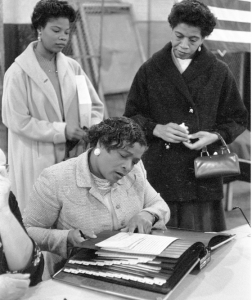3.5 Chapter Summary
Real Life Example: Disenfranchisement in the American South

Throughout the 1950s and 1960s in America, many southern states enacted policies to restrict the voting rights of black Americans. Many states employed literacy tests as barriers to voting. However, the tests weren’t actually intended to assess literacy; rather, they were used as a tool to prevent black citizens from casting votes. Below are a few sample questions from a test that was likely used in Louisiana.
Do what you are told to do in each statement, nothing more, nothing less. Be careful, as one wrong answer denotes failure of the test.
- Draw a line around the number or letter of this sentence
- Draw a line under the last word in this line
- Cross out the longest word in this line
- Draw a line around the shortest word in this line
- Circle the first, first letter of the alphabet in this line
- In the space below, draw three circles, one inside (engulfed by) the other
- Above the letter X make a small cross
(Onion, 2013)

How would you do?
- Could you answer any of the questions correctly?
- Would you feel confident in your answers?
If the questions seem confusing, that is by design. The (white) poll clerk would ultimately determine whether the answers were correct.
Chapter Summary
In this Chapter,
- Voting is fundamental to democratic legitimacy, but eligibility is governed by criteria such as age, citizenship, and residency, collectively known as the franchise.
- Most countries set the minimum voting age at 18, though some allow younger voters; lowering the voting age may improve turnout, but could lead to increased support for extremist candidates.
- Citizenship requirements often exclude non-citizens such as temporary residents and international students, with some countries also imposing additional residency rules.
- Historically, voting rights were restricted by property ownership, religion, race, gender, and geography; these exclusions were used to disenfranchise large portions of the population.
- Women’s suffrage movements in the UK and North America, led by figures like Emmeline Pankhurst and Nellie McClung, fought for and gradually secured voting rights for women across many countries.
- Disenfranchisement persists today through incarceration laws, with varying policies worldwide; the U.S. enforces especially harsh restrictions on felons, both during and after imprisonment.
- Voter registration laws, particularly in the U.S., have historically and currently functioned to exclude marginalized groups through ID requirements, literacy tests, and other discriminatory practices.
- Compulsory voting, used in countries like Australia and Belgium, raises voter turnout and aims to equalize representation, though it may also increase the number of invalid or protest votes.
OpenAI. (2025, May 27th). ChatGPT. [Large language model]. https://www.chatgpt.com Prompt: Can you please summarize the passage into 8 key points with no additional bullets? Edited & Reviewed by author.
Key Terms
- Compulsory voting – A legal requirement for eligible citizens to participate in elections. Under this system, individuals must attend a polling place on election day and may face penalties (such as fines) if they fail to do so, even if they choose not to cast a vote.
- Disenfranchise – To deny or restrict someone’s right to vote. Disenfranchisement can occur through legal exclusions (e.g., due to incarceration) or structural barriers (e.g., voter ID laws).
- Franchise – The legal right to vote in public elections. It determines who is eligible to participate in the electoral process.
- Suffrage Movement – The right to vote in political elections. Often used in historical contexts to describe movements, such as women’s suffrage, that fought to extend this right to excluded groups.

